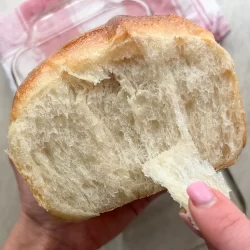
Softest Vegan Sandwich Bread Recipe (Dairy-Free, No Butter, No Milk)
Discover the BEST vegan sandwich bread recipe—soft, fluffy, and completely dairy-free. This easy homemade bread requires no butter and no milk, perfect for all your sandwich needs - vegan or not.
Equipment
- 1 loaf tin 23 x 13 x 6 cm
Ingredients
For the Yudane (dough conditioner)
- 66 g white bread flour about 1/2 cup + 1 tbsp
- 66 g boiling water about 1/4 cup + 1 tbsp
For the main dough
- 356g g white bread flour 2 3/4 cups
- 210 g water 7/8 cup (just under a cup)
- 40 g granulated sugar about 3 tbsp + 1 tsp
- 46 g vegetable oil (sunflower/canola) about 3 tbsp + 1 tsp
- 7 g salt about 1 1/4 tsp
- 7 g instant yeast 1 packet
Instructions
For the Yudane (Dough Conditioner):
- In a small bowl, combine the white bread flour with boiling water.66 g white bread flour, 66 g boiling water
- Stir until a thick paste forms. It's fine if it's a little clumpy.
- Set the Yudane aside to cool for about 20-30 minutes.
For the Main Dough:
- In a large mixing bowl, whisk together the water, vegetable oil, sugar, salt and instant yeast until well combined.
- Add the white bread flour to the bowl, mixing with a wooden spoon or the stand mixer on low speed until a dough forms and there are no dry spots.
- Cover the dough in plastic or a damp cloth and let it rest for 20 minutes (this is the autolyse period, which helps the flour fully hydrate and begin gluten development).
- After the 20-minute autolyse, add the cooled Yudane mixture and knead for 10-12 minutes by hand or 8-10 minutes in the mixer until the dough is smooth and elastic. If the dough sticks to your hands, lightly oil your hands when kneading.
- The dough should pass the windowpane test: stretch a small piece of dough until it’s thin enough to let light through without tearing. If it tears before it's thin enough, knead or mix for a few more minutes and test again.
- Place the dough in a lightly oiled bowl, cover with plastic or a damp cloth, and let it proof in a warm place (24-28°C) until doubled in size, about 1 hour.
- Poke Test: After the dough has been proofing, gently press a finger into the dough about 2 cm deep. If the indentation does not spring back, or only partially springs back slowly, the dough has risen enough. If the dough springs back quickly and fully, allow it to proof longer.
Shaping and Proofing:
- Grease a 23 x 13 x 6 cm loaf pan.
- Once the dough has doubled in size, turn it out onto a lightly oiled surface.
- Roll it out with a rolling pin into a log shape and pinch the ends to seal it.
- Place the rolled dough into the greased loaf pan. Cover with plastic or a damp cloth and let it proof for another 70-75 minutes in a warm place (time will differ based on temperature), until the dough is about 2 cm above the rim of the pan.
Baking:
- Preheat your oven to 190°C (350°F).
- Spray or brush the top of your loaf with a little bit of water. You can also use a dairy-free milk or egg wash if you want a shinier loaf.
- Bake the loaf at 190°C for 30-35 minutes until the top of the bread is golden brown. To add a little steam and prevent the load from cracking, you can add a baking sheet to the bottom of the oven and throw in 2-3 ice cubes (optional).
- Remove the bread from the loaf pan and cool on a wire rack for at least 30 minutes before slicing. Enjoy warm or at room temperature.
- Storage:
- - Store in a large bread bag on the counter. Best enjoyed within 2-3 days.
- - This loaf freezes very well so you can slice it and store in a large freezer bag.
Notes
How to UseSourdough Starter Instead of Instant Yeast:
You can use a sourdough starter instead of instant yeast for this recipe, though it will extend the rising time. If you are using discard, you can keep the instant yeast in to help it rise but reduce the water and flour according to the instructions below.
How to Adjust the Recipe:
- Measure your sourdough starter in grams (e.g., 70g).
- Divide that amount by 2 (e.g., 70g ÷ 2 = 35g).
- Subtract the result from both the flour and water amounts in the recipe:
- For flour: Subtract the result from the total flour (e.g., 356g - 35g = 321g).
- For water: Subtract the result from the total water (e.g., 210g - 35g = 175g).
- Add the sourdough starter to the bowl first, then your water, sugar, yeast and whisk to combine.
- Add flour and salt (don't put salt on top of the starter)
- Follow the rest of the recipe as described.